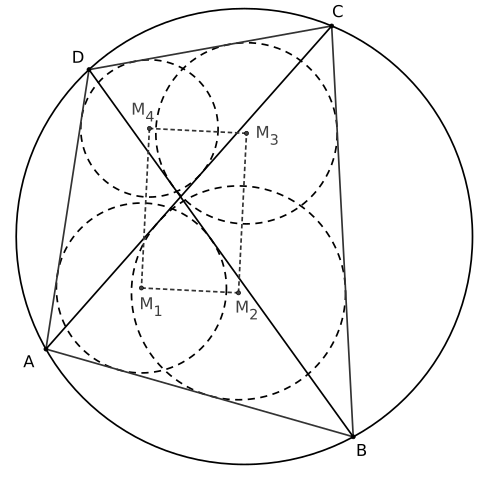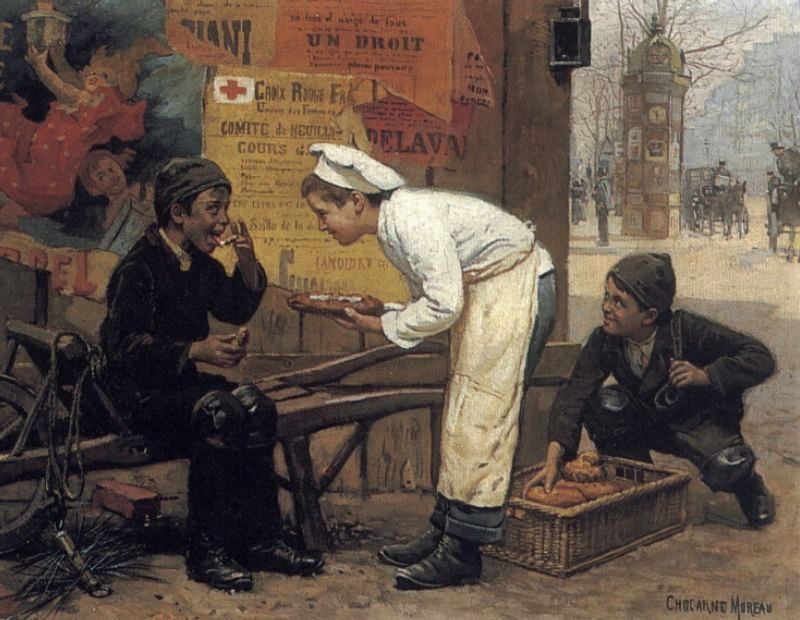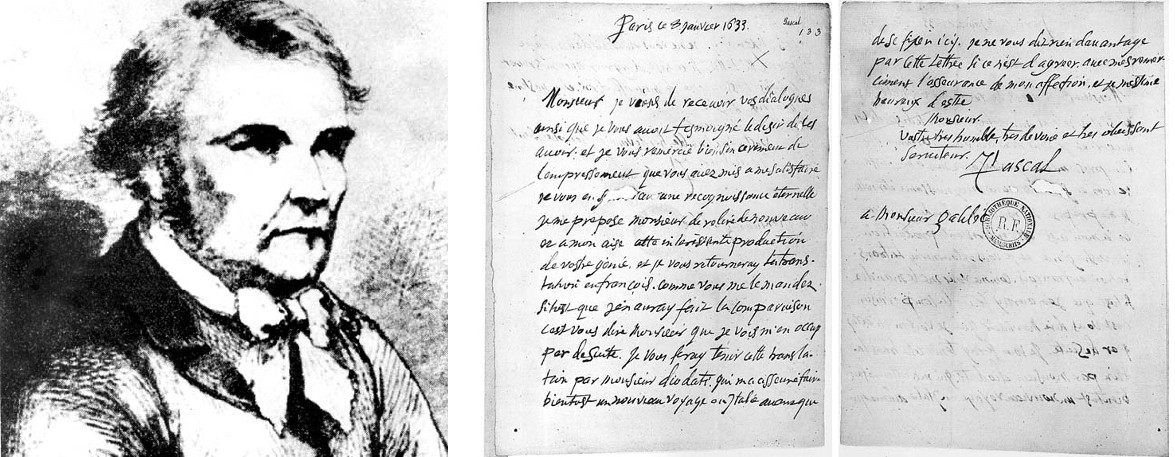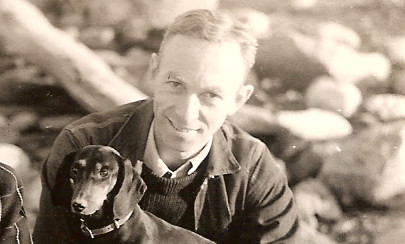
The crows like to insist a single crow is enough to destroy heaven. This is incontestably true, but it says nothing about heaven, because heaven is just another way of saying: the impossibility of crows.
— Kafka

The crows like to insist a single crow is enough to destroy heaven. This is incontestably true, but it says nothing about heaven, because heaven is just another way of saying: the impossibility of crows.
— Kafka

Choose any four points on a circle and join them to form a quadrilateral. Drawing the diagonals of this quadrilateral produces four overlapping triangles (each diagonal creates two of them).
Draw the largest possible circle in each of these triangles, and the centers of these circles will always form a rectangle:

In his autobiography, Benjamin Franklin describes mollifying a rival legislator in the Pennsylvania statehouse:
Having heard that he had in his library a certain very scarce and curious book, I wrote a note to him, expressing my desire of perusing that book, and requesting he would do me the favour of lending it to me for a few days. He sent it immediately, and I return’d it in about a week with another note, expressing strongly my sense of the favour. When we next met in the House, he spoke to me (which he had never done before), and with great civility; and he ever after manifested a readiness to serve me on all occasions, so that we became great friends, and our friendship continued to his death.
This seems to be a real psychological phenomenon — you can sometimes more reliably make a friend by asking a favor than by doing one, or, as Franklin put it, “He that has once done you a kindness will be more ready to do you another, than he whom you yourself have obliged.”
In a 1969 study, subjects who had won money in a question-and-answer competition were asked to return it; those whom the researcher himself approached reported liking him more than those who’d been approached by a secretary. In another study, students were assigned a teaching task using two different methods, one in which they encouraged their students and one in which they insulted and criticized them. In a debriefing they rated the students they’d encouraged to be more likable and attractive than those they’d insulted. That may reveal a converse principle, that we devalue others in order to justify wronging them.
(Jon Jecker and David Landy, “Liking a Person as a Function of Doing Him a Favour,” Human Relations 22:4 [1969], 371-378; John Schopler and John S. Compere, “Effects of Being Kind or Harsh to Another on Liking,” Journal of Personality and Social Psychology 20:2 (1971), 155.)

“Evil is committed without effort, naturally, fatally; goodness is always the product of some art.” — Baudelaire

Northumberland’s Alnwick Garden contains a special section full of hemlock, belladonna, foxglove, deadly nightshade, Brugmansia, Laburnum, and the botanical ingredients of strychnine and ricin.
“If you’re building something, especially a visitor attraction, it needs to be something really unique,” Jane Percy, the Duchess of Northumberland, who designed the garden, told Smithsonian. “One of the things I hate in this day and age is the standardization of everything. I thought, ‘Let’s try and do something really different.'”
She collected more than 100 varieties, which visitors are forbidden to touch, taste, or smell. (Even so, in 2014 seven visitors reportedly fainted from inhaling the fumes alone.)
“I thought, ‘This is a way to interest children,'” the duchess said. “Children don’t care that aspirin comes from a bark of a tree. What’s really interesting is to know how a plant kills you, and how the patient dies, and what you feel like before you die.”

I will, as briefly as I may,
The sweets of liberty display.
A Wolf half famish’d, chanced to see
A Dog, as fat as dog could be:
For one day meeting on the road,
They mutual compliments bestowed:
“Prithee,” says Isgrim, faint and weak,
“How came you so well fed and sleek?
I starve, though stronger of the two.”
“It will be just as well with you,”
The Dog quite cool and frank replied,
“If with my master you’ll abide.”
“For what?” “Why merely to attend,
And from night thieves the door defend.”
“I gladly will accept the post,
What! shall I bear with snow and frost
And all this rough inclement plight,
Rather than have a home at night,
And feed on plenty at my ease?”
“Come, then, with me” — the Wolf agrees.
But as they went the mark he found,
Where the Dog’s collar had been bound:
“What’s this, my friend?” “Why, nothing.”
“Nay, Be more explicit, sir, I pray.”
“I’m somewhat fierce and apt to bite,
Therefore they hold me pretty tight,
That in the day-time I may sleep,
And night by night my vigils keep.
At evening tide they let me out,
And then I freely walk about:
Bread comes without a care of mine.
I from my master’s table dine;
The servants throw me many a scrap,
With choice of pot-liquor to lap;
So, I’ve my bellyful, you find.”
“But can you go where you’ve a mind?”
“Not always, to be flat and plain.”
“Then, Dog, enjoy your post again,
For to remain this servile thing,
Old Isgrim would not be a king.”
— Phaedrus
Australian commuter train driver Ian Silva spends his free time building a world — a jaw-droppingly detailed Indian Ocean republic called the Koana Islands, whose 32 islands, nine major cities, 11 national parks, and 93 million residents exist only in his imagination.
Silva’s pastime came to light in this innocent Reddit thread five years ago, and Wired followed up with an interview:
The Koana Islands, he explains, are located south of the equator roughly between Madagascar, Indonesia and Australia. It has thirteen states, and sprawls three climate zones. The population is mostly white, and speaks a language that is derived from mixing English and Swedish settlers. The country industrialized relatively late, but did so quickly, becoming the world’s best place to earn a living by the 1970s. It is routinely ranked among the world’s best countries to live. Civic engagement is high, and the country has an extensive public welfare system, including the famous public transit system. Crime is low, but if you find yourself trouble, you can dial 777 for assistance.
For those who want to know more, Silva maintains a wiki and a subreddit. “I’m a very quiet person with strong opinions,” he says, “and the beauty of building a fictional nation is it gives you an outlet to express those things.”
(Thanks, Nick.)
When Florence Ilott began working at the House of Commons in the early 1930s, she learned that the staff there had set a standing challenge: to run across Westminster Bridge in the time it took Big Ben to strike noon. An amateur sprinter, Ilott donned her running gear and on April 14, 1934, became the first person to fulfill the challenge, as witnessed by reporters and photographers from the Associated Press, the Daily Sketch, and the Evening Standard.
The feat was reported in other newspapers around the world, but in researching this story recently with his father, Ilott’s grandson, Scott Pack, found a more compelling record:
(Via MetaFilter.)

Denis Vrain-Lucas was an undistinguished forger until he met gullible collector Michel Chasles. Through the 1860s Lucas sold Chasles thousands of phony letters by everyone from Plato to Louis the 14th, earning thousands of francs and touching off a firestorm among confused scholars. In this week’s episode of the Futility Closet podcast we’ll trace the career of the world’s most prolific forger.
We’ll also count Queen Elizabeth’s eggs and puzzle over a destroyed car.

A reader once wrote to E.B. White:
Dear Mr. White,
I’m omitting needless words!
Sincerely yours,
[a reader]
He wrote back:
Dear Ms. ——
Thanks. So am I.
Yrs,
E.B. White
(From Mark Garvey, Stylized: A Slightly Obsessive History of Strunk & White’s The Elements of Style, 2009.)